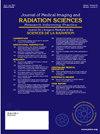Optimizing Imaging Practices for ECMO-Supported Patients: Experiential Insights from Interdisciplinary Collaboration in Intensive Care
IF 1.3
Q3 RADIOLOGY, NUCLEAR MEDICINE & MEDICAL IMAGING
Journal of Medical Imaging and Radiation Sciences
Pub Date : 2024-10-01
DOI:10.1016/j.jmir.2024.101524
引用次数: 0
Abstract
Background/Purpose
The utilization of ECMO (Extracorporeal Membrane Oxygenation) has surged in intensive care units, particularly amid the COVID-19 pandemic, presenting unique challenges for imaging services. This work aims to optimize practices and consolidate solutions based on experiential insights to address the complexities associated with ECMO patient care and imaging procedures.
Methods
Drawing from experiential knowledge and interdisciplinary collaboration, this retrospective analysis explores adaptations in patient handling and imaging protocol for individuals undergoing ECMO support. Insights were derived from multidisciplinary discussions and feedback, focusing on ECMO-specific considerations and scan acquisition nuances.
Results
Collaborative efforts between imaging and intensive care teams identified crucial adjustments in patient management to mitigate risks effectively. Furthermore, insights into ECMO configurations and their implications on imaging procedures contributed to a reduction in non-diagnostic scans, thereby enhancing patient care, albeit persistent challenges.
Conclusion
Through experiential learning and interdisciplinary collaboration, practices can be optimized to minimize non-diagnostic scans and associated risks in ECMO-supported patients. Continual refinement of protocols based on experiential insights is essential for improving patient outcomes in this complex clinical setting.
优化 ECMO 支持患者的成像实践:重症监护跨学科合作的经验启示
背景/目的重症监护病房对 ECMO(体外膜肺氧合)的使用激增,尤其是在 COVID-19 大流行期间,给影像服务带来了独特的挑战。这项工作旨在根据经验见解优化实践并整合解决方案,以解决与 ECMO 患者护理和成像程序相关的复杂问题。方法这项回顾性分析从经验知识和跨学科合作中汲取养分,探讨了对接受 ECMO 支持的患者处理和成像方案的调整。结果成像和重症监护团队之间的合作确定了患者管理的关键调整,以有效降低风险。此外,对 ECMO 配置及其对成像程序的影响的深入了解有助于减少非诊断性扫描,从而加强对患者的护理,尽管挑战依然存在。在这一复杂的临床环境中,根据经验不断改进方案对改善患者预后至关重要。
本文章由计算机程序翻译,如有差异,请以英文原文为准。
求助全文
约1分钟内获得全文
求助全文
来源期刊

Journal of Medical Imaging and Radiation Sciences
RADIOLOGY, NUCLEAR MEDICINE & MEDICAL IMAGING-
CiteScore
2.30
自引率
11.10%
发文量
231
审稿时长
53 days
期刊介绍:
Journal of Medical Imaging and Radiation Sciences is the official peer-reviewed journal of the Canadian Association of Medical Radiation Technologists. This journal is published four times a year and is circulated to approximately 11,000 medical radiation technologists, libraries and radiology departments throughout Canada, the United States and overseas. The Journal publishes articles on recent research, new technology and techniques, professional practices, technologists viewpoints as well as relevant book reviews.
 求助内容:
求助内容: 应助结果提醒方式:
应助结果提醒方式:


